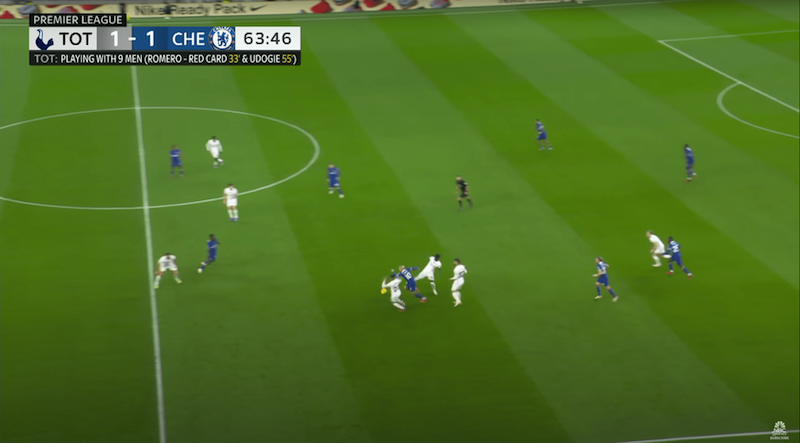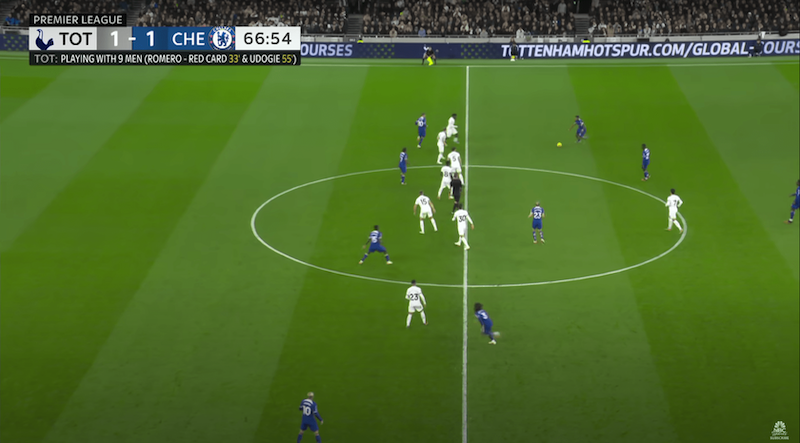Momentum Does Not Exist: Train for the process, not the result
How do you measure success? Is it the result at the end of the game? Is it more long term, like where you end up in the table? Or is it something more process driven, like a philosophy or a style of play?
When Rio Ferdinand asked Ange Postecoglou about a specific clip regarding Tottenham’s lack of high press in preseason, Ange responded, “What we’re focusing now… is this [points to the score on the screen], what the score is and what the time is. So now, we’re not playing our football. We’re reacting to something up there [points to the score], something external. If you’re going to react to that, you’re never going to be committed to anything.”
In this case, the scoreline and time dictated their actions. This is extremely common, often referred to as ‘Momentum’. As fans we have seen it. As players, we have felt it. The pressure of a game creates an emotion or an ‘energy’ that controls how players behave, often resulting in actions that are unlike how they typically act. This is what Ange is saw in his players in that clip.
The question is what is “momentum”?
I’m going to answer that question and how to avoid it all together with a first-hand experience.
THE SCENARIO
First, I’m going to describe scenario to you as I experienced it.
Two minutes into the game, we give up a penalty kick. We’re down 1-0. The rest of the half, it feels like we are in complete control of the game. We go into halftime losing 1-0 but I feel confident if the boys keep playing how they are playing, they will turn it around.
30 seconds into the second half, we score. It’s 1-1. Four minutes later, we score again. It’s 2-1. We continue to control the game. The “momentum and energy” feel to be in our favor. 13 minutes before the end of the game, we score again. It’s 3-1.
But then 10 minutes before the end of the game, we give up another penalty kick. It’s 3-2. Now, the “momentum and energy” seems to be in their favor. They create chance after chance. One minute before the end of the game, they score. It finishes 3-3.
As I reflect on my way home, I start thinking about “momentum and energy”. I’m a logical person so I need to explore this more. Later on, I texted my colleague Chris Bentley about it. With one simple question, he unravels this intangible idea of momentum and energy for me.
“WHAT BEHAVIORS ARE REFLECTED IN “MOMENTUM”?”
Now I’m going to describe it to you as I re-watched it on video.
The game starts and the boys are flying to press the ball carrier. There is immediate pressure every time we lose possession. This high press continues for most of the game. In the first 25 minutes, the opposition attempts to build up with their backline but the high press is successful and we pin them in their half of the field.
At the start of the second half, our immediate pressure creates two quick goals. This continues throughout this half allowing us to keep the ball in the opposition’s half. This was the “momentum”. This is the tangible player behavior that caused the players and myself to feel the “momentum and energy” of the game. After they score to make it 3-2, everything changes. The immediate pressure is gone. Upon losing possession, there is a retreat towards our goal.
With the help of Chris’ question and the video, I was able to land on the actionable, tangible description of what happened. It’s moments like this in my coaching that show me the importance of outside input to be able to grow as a coach. Chris provides me a thought to get me out of the echo chamber of my own thinking and the video provides me the visual proof of what happened. Without these two elements, I would have been stuck with trying to solve “energy” and “momentum” in training.
However, this doesn’t end here.
The next step is getting the players’ perspective about why there was a change in behavior after the opposition’s second goal.
THE MOST IMPORTANT PERSPECTIVE: The PLAYERS’
It would have been very easy for me to assume the reason for the players not pressing in the final minutes of the game like they had previously. For example, maybe they were tired. This would have been a logical conclusion.
However, without asking them their perspective I would have entirely taken them out of the development process. And this would have been illogical, because ultimately, it is THEIR development. The players’ perspective is the most important one because they are the protagonists of this game.
Monday afternoon I had a short virtual meeting. I came prepared with clips of pressing actions throughout the game and clips of them not pressing in the last ten minutes.
We watched the videos and then it was time for them to share their perspective.
“You noticed in the first set of clips we pressed them every time we lost the ball and in the second set of clips we were retreating when we lost the ball. Why did we stop pressing them after they scored their second goal?”
After some prodding and poking their answers to encourage deeper reflection, they came to the conclusion that there was a fear of losing. They felt there wasn’t much time left and they didn’t want to get scored on again so they wanted to protect our goal. They also told me that they could hear the parents and the other coach yelling more after they scored the second goal.
REFLECTING ON THE ENVIRONMENT I HAD CREATED
It made me reflect on the language that I use regarding competition. It made me think about where I needed to direct their attention in moments like this one.
The answer was simple; at that moment when the opposition scored their second goal, they had shifted to result oriented instead of process oriented. They told me that they felt a fear of losing towards the end of the game. Their focus had gone to the outcome of the game instead of all the things they did well to get to that point.
This entire process made me reflect on my role in helping my young players in situations like the one where they felt the need to win, which ultimately led to a fear of losing. This detracted from their ability to think about the actions that had helped them play well.
My reflection led me to two changes to help them maintain their ability to think “process” regardless of the pressure during certain situations like the one they had experienced.
THE FIRST CHANGE
The first change was directing their attention to our team principles as solutions to football moments.
The following two weeks after that match, training consisted of many small-sided games, with each day focusing our reflection on how we use each of our four team principles to solve attacking, defending, and transitioning at a team level. The reasoning behind this was for them to become aware of the purpose of each team principle as a SOLUTION. I wanted them to experience the usefulness of our team principles.
THE SECOND CHANGE
The second change that I made was how I managed my language on match days.
I realized that I needed to be more explicit in how I directed their attention towards our team principles during the match, especially in emotional matches. We played a friendly against an older team that I knew was going to frustrate them. They were going to be more emotional than usual and it was the perfect situation to train bringing their attention back to our principles. I observed, and when I noticed their emotional responses start to prevent their ability to think about their actions in relation to contributing to the team principles, I used my language to bring them back to the team principles, and thus contribution to the team.
Of course, this does not end here.
As you may have noticed, in this solution I play a protagonist role which is a problem. Ultimately, I want my players to be self-regulating; to not need me in the game. So as I consistently direct their attention to team principles, they will inevitably start to do it themselves. When this starts to happen, that’s when I can start to step away and allow them to be in control. I model the behavior for them to take over and ultimately become self-regulating.
BACK TO ANGE
Four months into the season and it’s entirely different.
Against Chelsea, playing with two men down, matched tied at 1-1 with 30 minutes left, Tottenham are steadfast to their football.
When nearly every team would be hunkering down to get a result, abandoning any kind of high press, Tottenham are playing like this.





We believe and feel that “momentum” is something which real, but what if we trained out of existence?
What if what triggered “momentum”, never entered the minds of the players?
What if we chose success?
Momentum does not exist.
What exists is what we do, and we choose what we do. We train what we do. We succeed by what we do.
